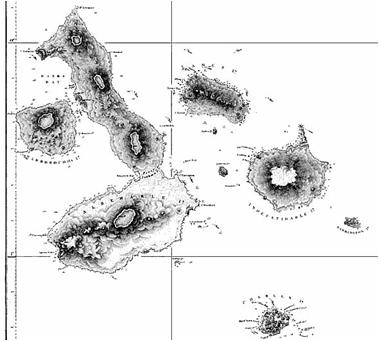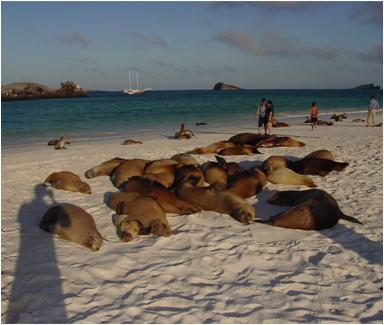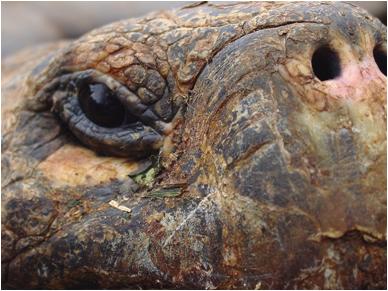Galapagos Conference Adds to Understanding – Part II
Dr. Guillermo Paz-y-Miño-C — © 2013
Department of Biology, University of Massachusetts Dartmouth
[click on title to be redirected to The Standard Times]
![]()
“…University San Francisco of Quito and its Galapagos Institute for the Arts and Sciences excelled at managing the III World Evolution Summit with unique vision and hospitality and at highlighting the scientific relevance of the Galapagos, its role in Charles Darwin’s conceptualization of “his theory” of evolution by natural selection, and the importance of this volcanic archipelago as World Heritage… USFQ and GAIAS are exemplars of a liberal arts model in the Americas, one that merges institutional identity with cultural heritage…”
I just represented UMassD at the World Evolution Summit, San Cristobal Island, Galapagos, Ecuador. The 200-attendee meeting took place June 1-5, 2013; it included 12 keynote addresses, 20 oral presentations by international scholars, and about 30 posters by, mostly, graduate and undergraduate students. It was the third Summit organized by University San Francisco of Quito (USFQ) and its Galapagos Institute for the Arts and Sciences (GAIAS). The Summit reverberates every four years.
Both USFQ and GAIAS excelled at managing the event with unique vision and hospitality and at highlighting the scientific relevance of the Galapagos, its role in Charles Darwin’s conceptualization of “his theory” of evolution by natural selection, and the importance of this volcanic archipelago as World Heritage. Darwin visited the Galapagos in 1835 during an amazing journey (1831-1836) on board of the HMS Beagle, an expedition vessel commanded by Captain Robert FitzRoy.
Above, map of the Galapagos Islands by Captain Robert FitzRoy (1836)
Above, HMS Beagle at Tierra del Fuego, painted by Conrad Martens, ship’s artist (1831-1836)
Under the umbrella “Why Does Evolution Matter?” the Summit included five sessions: evolution and society, pre-cellular evolution and the RNA world (RNA is a precursor molecule to DNA, the carrier of genetic coding), behavior and environment, genome, and microbes and diseases. Plus an unforgettable farewell party, Galapagean style, with live music, performances, and spirits. USFQ and GAIAS are skillful at including the Galapagos community in all events, which brings pride to all parties. USFQ and GAIAS are exemplars of a liberal arts model in the Americas, one that merges institutional identity with cultural heritage.
The Summit was publicized by the media worldwide with instant twitting, video uploading online, TV and radio reporters chasing the speakers, and press releases. The Galapagos might be distantly located 600 miles west of the coast of Ecuador, but the Summit was constantly “close by” in the news. Indeed, there is no place on Earth like the Galapagos Islands and no better destination to discuss the reality of evolution.
 Above, magnificent Swallow-tailed Gull. “…Indeed, there is no place on Earth like the Galapagos Islands and no better destination to discuss the reality of evolution…” Photo © 2009 Guillermo Paz-y-Miño-C.
Above, magnificent Swallow-tailed Gull. “…Indeed, there is no place on Earth like the Galapagos Islands and no better destination to discuss the reality of evolution…” Photo © 2009 Guillermo Paz-y-Miño-C.
I was invited by USFQ and GAIAS to present at the Summit my research program at UMassD. In my keynote address, I discussed “Evolution, Science, Pseudo Science and the Public’s Perception of Reality.” The topic is provocative and it did trigger sharp questions from the audience, dozens of twits, journalists impatient to get exclusive interviews, and an avalanche of sympathizers with my concerns about the low public’s acceptance of evolution worldwide. I contrasted with data the anecdotic perception, even among some of the co-keynote speakers, that opposition to evolution is a phenomenon restricted to the United States, and I framed the problem conceptually, subject to scientific inquiry and testing.
During the past five years, my collaborator Dr. Avelina Espinosa (professor at Roger Williams University) and I have documented scientifically the patterns of acceptance of evolution in New England and the attitudes toward science by highly educated audiences [download PDF of scientific article on Acceptance of Evolution in New England]. With so many reputable universities, New England is a great “field site” for our studies. We have proposed that the controversy over evolution versus creationism (including all its modern forms: theistic evolution, creation science, young-earth creationism, Intelligent Design, BioLogos) is intrinsic to the incompatibility between scientific rationalism/empiricism and the belief in supernatural causation.
 Dr. Espinosa and I have published extensively on the topic and tested quantitatively the “incompatibility hypothesis” which helps us understand the core reason for the controversy science versus belief. This was the essence of my keynote address at the World Evolution Summit and my colleagues’ response, plus that of the audience, were amazingly encouraging. The media went beyond: “it is time, and important, to say it the way it is” stated Rodolfo Asar, host of the TV program “On Myths and Truths: Frauds in Science” when dialoguing with Dr. Espinosa and me. Rodolfo and his co-host, Maria Eulalia Silva, play a crucial role in educating the public, their program is featured primetime by Teleamazonas.
Dr. Espinosa and I have published extensively on the topic and tested quantitatively the “incompatibility hypothesis” which helps us understand the core reason for the controversy science versus belief. This was the essence of my keynote address at the World Evolution Summit and my colleagues’ response, plus that of the audience, were amazingly encouraging. The media went beyond: “it is time, and important, to say it the way it is” stated Rodolfo Asar, host of the TV program “On Myths and Truths: Frauds in Science” when dialoguing with Dr. Espinosa and me. Rodolfo and his co-host, Maria Eulalia Silva, play a crucial role in educating the public, their program is featured primetime by Teleamazonas.
What is the incompatibility hypothesis, how do you test it?, asked Rodolfo. I explained that acceptance of evolution and scientific rationalism is characterized by three main factors: the level of an individual’s understanding of science, her/his familiarity with the process of evolution, and her/his personal belief convictions [download PDF of scientific article about the Incompatibility Hypothesis]. In all our studies with the New England professors, educators of prospective teachers, and college students, the single negatively associated variable with acceptance of evolution is the degree of religiosity. And to test it, we have compared such trend with the views of non-believers, who do not possess the academic credentials of the New England scholars, but their levels of understanding the foundations of science and evolution are comparable to the highly educated professors. “Evolution is true regardless of our awareness of it,” I concluded.
I must confess that the World Evolution Summit in the Galapagos shall remain as one of my most memorable experiences. — © 2013 by Guillermo Paz-y-Miño-C. all rights reserved.
Related Articles:







You must be logged in to post a comment.